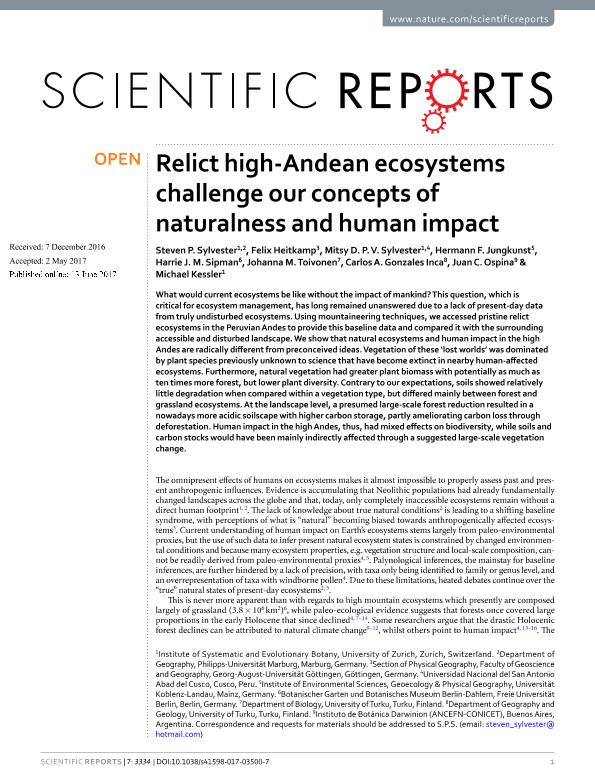Artículo
Relict high-Andean ecosystems challenge our concepts of naturalness and human impact
Sylvester, Steven P.; Heitkamp, Felix; Sylvester, Mitsy D. P. V.; Jungkunst, Hermann F.; Sipman, Harrie J. M.; Toivonen, Johanna M.; Gonzales Inca, Carlos A.; Ospina Gonzalez, Juan Camilo ; Kessler, Michael
; Kessler, Michael
 ; Kessler, Michael
; Kessler, Michael
Fecha de publicación:
06/2017
Editorial:
Nature Publishing Group
Revista:
Scientific Reports
ISSN:
2045-2322
Idioma:
Inglés
Tipo de recurso:
Artículo publicado
Clasificación temática:
Resumen
What would current ecosystems be like without the impact of mankind? This question, which is critical for ecosystem management, has long remained unanswered due to a lack of present-day data from truly undisturbed ecosystems. Using mountaineering techniques, we accessed pristine relict ecosystems in the Peruvian Andes to provide this baseline data and compared it with the surrounding accessible and disturbed landscape. We show that natural ecosystems and human impact in the high Andes are radically different from preconceived ideas. Vegetation of these ‘lost worlds’ was dominated by plant species previously unknown to science that have become extinct in nearby human-affected ecosystems. Furthermore, natural vegetation had greater plant biomass with potentially as much as ten times more forest, but lower plant diversity. Contrary to our expectations, soils showed relatively little degradation when compared within a vegetation type, but differed mainly between forest and grassland ecosystems. At the landscape level, a presumed large-scale forest reduction resulted in a nowadays more acidic soilscape with higher carbon storage, partly ameliorating carbon loss through deforestation. Human impact in the high Andes, thus, had mixed effects on biodiversity, while soils and carbon stocks would have been mainly indirectly affected through a suggested large-scale vegetation change.
Palabras clave:
Human Impact
,
Andes
,
Vegetation Change
Archivos asociados
Licencia
Identificadores
Colecciones
Articulos(IBODA)
Articulos de INST.DE BOTANICA DARWINION (I)
Articulos de INST.DE BOTANICA DARWINION (I)
Citación
Sylvester, Steven P.; Heitkamp, Felix; Sylvester, Mitsy D. P. V.; Jungkunst, Hermann F.; Sipman, Harrie J. M.; et al.; Relict high-Andean ecosystems challenge our concepts of naturalness and human impact; Nature Publishing Group; Scientific Reports; 7; 3334; 6-2017; 1-13
Compartir
Altmétricas



